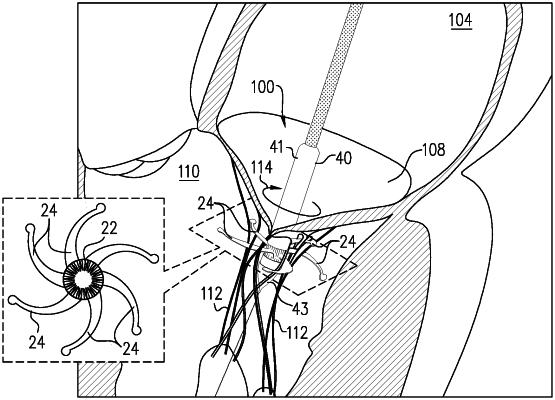| CPC A61F 2/2418 (2013.01) [A61F 2/2409 (2013.01); A61F 2/2427 (2013.01); A61F 2/2436 (2013.01); A61F 2/2457 (2013.01); A61F 2/2466 (2013.01); A61F 2220/0016 (2013.01); A61F 2220/005 (2013.01); A61F 2220/0058 (2013.01); A61F 2220/0075 (2013.01); A61F 2220/0091 (2013.01); A61F 2230/0067 (2013.01); A61F 2230/0069 (2013.01)] | 25 Claims |

|
1. Apparatus for use with prosthetic valve leaflets that are configured to be deployed within a native atrio-ventricular valve that is disposed between an atrium and a ventricle of a heart of a mammalian subject, the native atrio-ventricular valve including a valve annulus, valve leaflets, chords, and papillary muscles, the apparatus comprising:
a valve frame configured to support the prosthetic valve within the native atrio-ventricular valve, the valve frame comprising:
a valve-frame body, comprising:
an atrial part comprising a disc-shaped portion configured to be deployed on an atrial side of the valve annulus; and
a cylindrical part configured to couple to the prosthetic valve leaflets and configured to be deployed such that a ventricular end of the cylindrical part is disposed within the ventricle; and
a plurality of chord-recruiting arms configured to:
while the cylindrical part is at least partly radially constrained, assume a rotation configuration in which the chord-recruiting arms extend at least radially from the ventricular end of the cylindrical part and curve circumferentially around the cylindrical part in a given circumferential direction, wherein, in the rotation configuration of the chord-recruiting arms, the chord-recruiting arms are configured to recruit the chords when
at least a portion of the valve frame is rotated in the given circumferential direction, and while the cylindrical part is not radially constrained, assume a fully-deployed configuration in which the chord-recruiting arms extend less radially and more axially toward the atrial part, relative to the rotation configuration, such that the recruited chords and/or tissue of the native atrio-ventricular valve are trapped between the chord-recruiting arms and the valve-frame body.
|